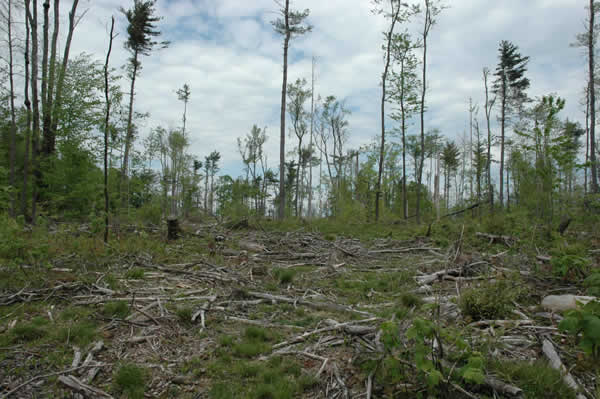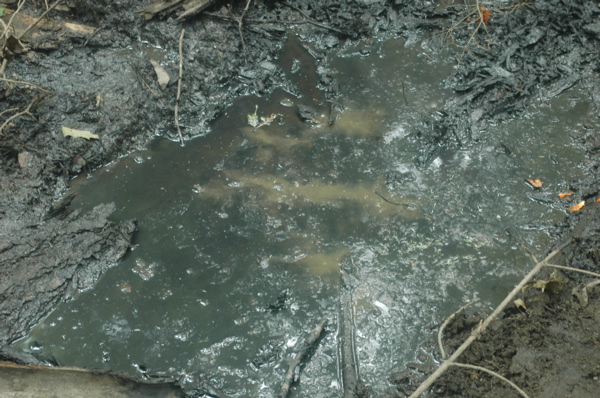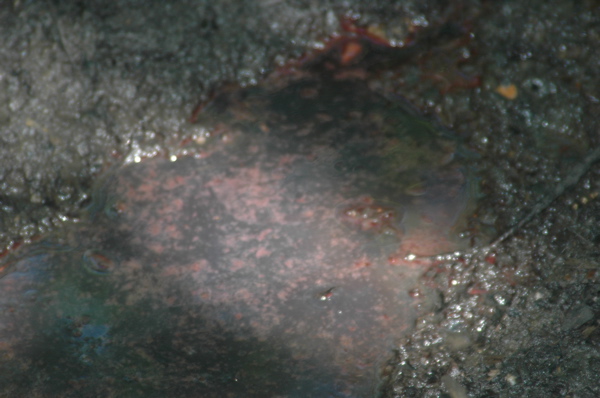Town Farm Logging Project Issues
UPDATE - May 2010
The logger that did the salvage cut was much better than the Puffers, who did the original project. They finished fairly quickly and their vehicles leaked very little oil and hydraulic fluid. They were also willing and able to put absorbent pads underneath their vehicles as needed. But after touring the softwood area, it looks like a bomb hit it. The area is a virtual clear cut full or prickers and ticks. The thinning of the Red Pine and Norway Spruce was supposed to protect the trees from wind and ice damage. Clearly, that did not work.

Project Forester Mary Wigmore informed me that the DCR refused to allow her to relocate the wetland away from the wetland area. Why they were not work to reduce possibility of pollution to our wetlands and water supply is unfathomable to me. In fact, when there were thunderstorms in the area, the old pollution from the original project was stirred up. Oil and hydraulic fluid was clear from sight and smell, just as I feared. No doubt, some washed down into the wetland. Still, DCR forester Nicholas Anzuoni is denying that are any problems in the area despite photos, lab reports, and physical evidence to the contrary. This type of behavior really hurts the DCR's reputation. They should be working with the community and the industry to address problems. They could have put in straw bales or just moved the landing. Instead, they continue to deny what is obvious to the people who use the area.
Here is a copy of the report that showed severe soil pollution of 1360 ppm in the landing area. Of course, to the DCR, this is a "so-called oil spill."
UPDATE - May 12, 2009
I talked to Mary Wigmore yesterday. Mary was hired by the Selectboard to manage a salvage cut in the Town Farm. According to Mary, the project should be quick (1 month) and will be done by a logger much more skilled in Best Management Practices. She also told me they would look at relocating the landing - if possible - away from the wetland system. I will be meeting with Mary and the logger soon on site. I am hopeful that this project will go much better than the previous project. The Selectboard never responded to 2 letters suggested that BMP clauses be built into future town logging contracts. However, I believe that working directly with Mary, who seems like an honest person who wants to do the right thing and work with neighbors - is the right approach.
Mary also let me know that Tom Bryon is no longer the forester for the state project. Nicholas Anzuoni is now the forester for the project. Mary thought that the sale will be reduced and the trees remarked to reduce the scope of the original project.
I am much more concerned about the 5 proposed biomass plants for Western Mass. For more info see,
http://clearcutma.blogspot.com/
http://www.massenvironmentalenergy.org/index.html
SUMMARY
Cricket Hill Road in Conway, Massachusetts has been protected under a conservation restriction by the Massachusetts Department of Conservation and Recreation (DCR) for its "unusual and outstanding qualities." Specifically, the area was cited for its "excellent wildlife habitat", a "valuable buffer" to the Conway State Forest, and for its part of the "Town of Northampton's public water supply watershed." Unfortunately, the same very DCR failed to protect the area and residents from severe pollution during their supervision of a Town of Conway logging project done by Lashway Lumber of Williamsburg, Massachusetts.
 A total of 18 spills covering over 100 square feet were documented by neighborhood residents. Multiple complaints were made to the Selectboard, Conservation Commission, DCR, and Department of Environmental Protection (DEP). Despite promises by the DEP and DCR that these problems would be addressed, the problems continued to the very end of the project. The spills occurred due to leaky logging equipment when parked or when loading logs. Loggers were supposed to use absorbent pads but repeatedly failed to do so. Loggers were seen using the pads for table clothes and hand wipes. The Project Supervisor did attempt to put down pads when spills were reported but pads were not maintained by loggers and quickly became saturated or blew over. On one of the last few days of the project, loggers were again loading logs without pads and spilling hydraulic oil. When a resident returned to photograph the 4 foot by 2 foot spill, the spill had disappeared. Careful examination revealed footprints and a compacted layer of soil over the spot the spill had been seen. When the soil was dug up, the spill was found underneath. Lashway loggers had the energy to cover up their pollution but not to clean it up or prevent it in the first place.
A total of 18 spills covering over 100 square feet were documented by neighborhood residents. Multiple complaints were made to the Selectboard, Conservation Commission, DCR, and Department of Environmental Protection (DEP). Despite promises by the DEP and DCR that these problems would be addressed, the problems continued to the very end of the project. The spills occurred due to leaky logging equipment when parked or when loading logs. Loggers were supposed to use absorbent pads but repeatedly failed to do so. Loggers were seen using the pads for table clothes and hand wipes. The Project Supervisor did attempt to put down pads when spills were reported but pads were not maintained by loggers and quickly became saturated or blew over. On one of the last few days of the project, loggers were again loading logs without pads and spilling hydraulic oil. When a resident returned to photograph the 4 foot by 2 foot spill, the spill had disappeared. Careful examination revealed footprints and a compacted layer of soil over the spot the spill had been seen. When the soil was dug up, the spill was found underneath. Lashway loggers had the energy to cover up their pollution but not to clean it up or prevent it in the first place.

The DCR located the landing area - where logs are loaded onto trucks for transport - within 50 feet of a large wetland system. We were very lucky that the wetland water supply was not polluted - at least when residents had the water tested at their own expense. The Best Management Practices for Logging manual strongly suggests locating landings more than 100 feet from wetland areas. Additionally, the DCR allowed leaky skidders and forwarding to park immediately next to a vernal pool, where residents have noted egg masses over the last 10 years. Lashway Lumber, the Town of Conway, and the DCR are extremely lucky that the adjacent wetland was not polluted (at least when local residents did a water test.) The adjacent wetland is one of the sources of the Town of Northampton's water supply.
The spills are not always easily visible but could be seen during a rainstorm or after a warm day of snow melt. The DEP was called in to investigate and found that some of the apparent pollution they saw was due to a bacteria that has a rainbow like sheen that looks like oil on water. We understand the areas that they saw this and they were only about 40% of the pollution we were seeing. Most of what we were seeing was due to the spills under skidders and log carriers or due to vehicles leaking oil traveling on Cricket Hill Road. A lot of this oil had washed away by the time the DEP visited the site. Meanwhile, the town claimed the all the pollution is caused by the bacteria, which is clearly false (see photos below.) The town also claimed that no efforts were made to work with local officials before reporting to the DEP, which is also incorrect as the emails show.
Significant amounts of petrochemicals ran off into our precious streams and ponds. The logging plan for this project painted an idyllic picture of the project as does this year's town annual report. However, for those of us that use these roads daily, the real story has been quite different. Daily oil spills and intense chemical fumes on our treasured trails became the norm.

Despite frequent calls to the Selectboard, DEP, DCR, and Conservation Commission to tour the area with local residents near the end of the project when pollution was at peak levels, town and state officials refused to tour the area. However, miraculously, after the area was bulldozed, some 7-8 state and local officials were suddenly available to examine the landing. Soil was tested in the 15 by 4 foot puddle shown on the left and show to have high levels of motor oil. A strong petrochemical smell and numerous oils spills were observed by many local residents. At the tour, DCR forester Alison Wright denied that there was oil in the puddle exactly where the soil sample was taken. The DCR issued a statement later that "no laws were broken" and "all questions were answered." It appears that the DCR is in denial about these issues and have, thus far, refused to be part of a solution to these problems so that don't occur again. It is clear that Best Management Practices clauses need to be added to Town logging contracts to prevent pollution like this from happening again.


For more info...
Oil Spill Summary Document (PDF)
Best Management Practices for Logging in Massachusetts (PDF)
